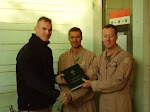Introitus
Ps 24:1-3Ad te levávi ánimam meam: Deus meus, in te confído, non erubéscam: neque irrídeant me inimíci mei: étenim univérsi, qui te exspéctant, non confundéntur.
Ps 24:4
Vias tuas, Dómine, demónstra mihi: et sémitas tuas édoce me.
V. Glória Patri, ...
V. The Lord be with you.
R. And with thy spirit.
Let us pray.
Put forth Your power, O Lord, we beseech You, and come, that with You as our protector we may be rescued from the impending danger of our sins; and with You as our deliverer, may we obtain our salvation.
Who livest and reignest with God the Father, in the unity of the Holy Spirit, God, world without end.
R. Amen
Let us pray.
Commemoration St. Sabbas, Abbot
May the intercession of the blessed Abbot Sabbas, commend us to You, O Lord, so that through his merits we may obtain that which we cannot accomplish by our own.
de S. Maria Advent
O God, Who, by the message of an Angel, willed to take flesh in the womb of the Blessed Virgin Mary, grant that we, your suppliants, who believe her to be truly the Mother of God, may be helped by her intercession with You.
Through the same Jesus Christ, thy Son, Our Lord, Who liveth and reigneth with thee in the unity of the Holy Ghost, God, world without end.
R. Amen.
S. And with thy spirit.
The beginning ++ of the holy Gospel according to John
R. Glory be to Thee, O Lord.
John 1, 1-14
In the beginning was the Word, and the Word was with God, and the Word was God. The same was in the beginning with God. All things were made by Him, and without Him was made nothing that was made: in Him was life, and the life was the Light of men; and the Light shineth in darkness, and the darkness did not comprehend it. There was a man sent from God, whose name was John. This man came for a witness, to testify concerning the Light, that all might believe through Him. He was not the Light, but he was to testify concerning the Light. That was the true Light, which enlighteneth every man that cometh into this world. He was in the world, and the world was made by Him, and the world knew Him not. He came unto His own, and His own received Him not. But as many as received Him to them He gave power to become sons of God, to them that believe in His Name, who are born not of blood, nor of the will of the flesh, nor of the will of man, but of God. Here all kneel. And the Word was made flesh, and dwelt among us: and we saw His glory, the glory as of the Only begotten of the Father, full of grace and truth.
P. The Lord be with you.
S. And with thy spirit.
Let us pray.
May we receive Your mercy, O Lord, in the midst of Your temple, and thus prepare with due observance for the coming festal season of our redemption.
Through Jesus Christ, thy Son our Lord, Who liveth and reigneth with thee, in the unity of the Holy Ghost, God, world without end.
R. Amen.
Let us pray.
Commemoration St. Sabbas, Abbot
May the pleading of the blessed Abbot Sabbas for us, together with the partaking of Your sacrament, protect us, O Lord, so that we, mindful of his way of life, may obtain the help of his intercession.
de S. Maria Advent
May this Communion, O Lord, cleanse us of sin, and by the intercession of the Blessed Virgin Mary, the Mother of God, may it make us sharers of heavenly healing.
Through the same Jesus Christ, thy Son, Our Lord, Who liveth and reigneth with thee in the unity of the Holy Ghost, God, world without end.
R. Amen.










